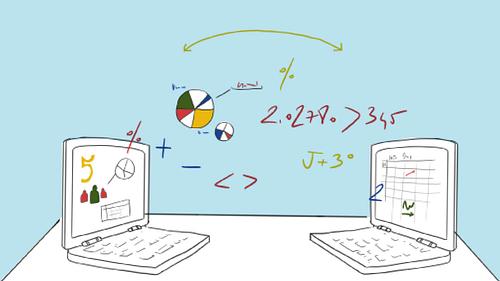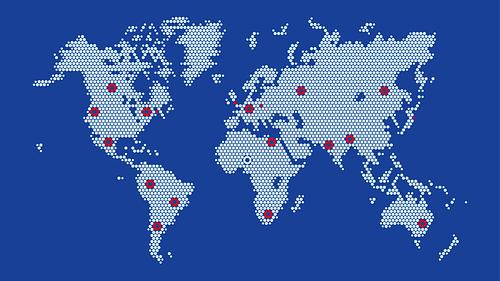
Context and learning objectives
The increasing accessibility of geolocated data, from which complex spatial analyses can be conducted, offers new perspectives for tax and customs administrations. Combining geography, statistics, satellite image analysis, and cartography, Geo-intelligence (GeoInt) provides an enhanced understanding of the terrain and the spatialized phenomena taking place there.
This training, rich in content and feedback from experience, practice-oriented, introduces QGIS, the open-source software for geographic information management. It serves as a guide to understanding and handling geolocated data in order to support informed and proactive decision-making.
We will discover 3 key concepts: geolocated data, GIS, and GeoInt. They are the foundation layer of spatial analysis.
This module will provide you some key milestones on the birth of these concepts, and then present a set of geospatial data/information sources, and examples of geospatial analysis in different fields, to show you the possibilities offered by the GeoInt.
Learn to install and get started with QGIS and its workspace.
To understand the different data formats used in the geospatial world. Familiarity with these formats and cartographic projections is crucial for achieving mastery in your work.
After understanding the different data formats and how to integrate them, you will discover how to use QGIS to enter geographic data. The goal is to prepare you to use QGIS tools to create or modify usable geographic data.
To produce cartographic and geographical knowledge, you need to be able to analyse and geo-process data.
You mostly need to know a few key functions to cover a wide range of needs. By the end of this module, you will master these key functions and will be able to perform useful geoprocessing for your work as a customs officer.
GIS Software not only enables spatial analysis but also facilitates the representation of geographical data and maps creation. In this module, we will focus on creating advanced maps in QGIS by representing complex statistical variables, such as population stock, facilities or population density.
This last module is a guide to other sources of geospatial data or satellite imagery, most of them are free. You can consult, download, and use these resources in QGIS to enhance the picture and the understanding of your area of interest. Using the available data will reduce the effort to produce geospatial information.
Although the use of open geospatial data and satellite imagery can be valuable, it must be combined with an analysis of its quality. geospatial maps and data are inherently imperfect, offering a simplified and reductive view of the territory. They are always behind developments in the field. This second objective of this concluding module aims to provide methods and tips-and-tricks to analyze geospatial data quality.
Target audience
General public
Format
This training is delivered online, offering learners complete flexibility through unlimited access to content, available 24/7 on the IHEDD distance learning platform. Each participant can progress at their own speed, depending on their availability.
To encourage exchange and mutual support, a forum is available in the training space, complemented by a WhatsApp group to create a community of learners.
Modalités
Cette formation est dispensée en ligne, offrant aux apprenant·es une flexibilité totale grâce à un accès illimité aux contenus, disponibles 24h/24 et 7j/7 sur la plateforme d’enseignement à distance de l’IHEDD. Chaque participant·e peut ainsi avancer à son propre rythme, selon ses disponibilités.
Pour favoriser l’échange et l’entraide, un forum est mis à disposition sur l’espace de formation, complété par un groupe WhatsApp permettant de créer une communauté d’apprenants.
En complément, des rendez-vous réguliers en visioconférence (classe virtuelle) sont organisés avec les formateur·rices et la communauté d’apprenant·es. Ces sessions permettent d’approfondir les notions abordées, d’échanger sur les problématiques rencontrées et d’obtenir des réponses aux questions.
Validation des acquis
At the end of the course, IHEDD will award a certificate on behalf of Ferdi, a recognised professional training organisation. This certificate states the name of the course and the total number of validated training hours. The certification is subject to passing a final evaluation in the form of an assignment designed by the trainer.
Historique des sessions précédentes
24 june – 15 july 2024 : 15 participants | 73% pass rate
14 april – 19 may 2025 : 11 participants | 45% pass rate
Infos pratiques
- Durée : 9h30 of self-paced work on modules + 7h30 of live virtual classes
- La formation est délivrée en English
- Matériel : Il est indispensable de disposer d’un ordinateur et d’une connexion internet.
- La formation est accessible aux personnes en situation de handicap.
- Prérequis : no previous academic qualifications needed
- Nombre de places : 40
Participation aux frais de formation
Responsable de formation
- Nicolas SAPORITIDirecteur général (Geo212), geospatial analyst

Formatrices et formateurs
- Nicolas SAPORITIDirecteur général (Geo212), geospatial analyst

- Timothée ROSIERIngénieur géomaticien (Geo212)



